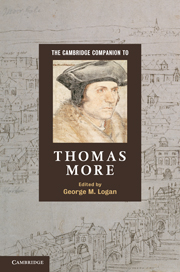Book contents
1 - The making of a London citizen
from Part I - Life, times and work
Published online by Cambridge University Press: 28 May 2011
Summary
Thomas More, like everyone else, had thirty immediate ancestors stretching back to the generation of his great-great-grandparents: we know the names of only eight of these thirty men and women, but, even so, that is probably more than is known about the forebears of most middle-ranking Londoners in the late fifteenth century.We might think, perhaps, of these thirty ancestors forming a chorus line on a stage, each lit by a spotlight and all equally important. But twenty-two of the spotlights have broken and so only eight of the chorus are visible. In the epitaph which he composed for himself, More wrote that he was born ‘urbe Londinensi, familia non celebri sed honesta’ (EE 10:260). And, indeed, those members of his family whom we can trace bear out this modest claim. Both his parents were Londoners, and so were his known grandparents, great-grandparents and great-great-grandparents. Such a long London pedigree is very unusual in the fifteenth century. The population of the City in this period – numbering about 50,000 – was replenished, indeed maintained, by a flow of immigrants from the surrounding countryside; so the thick London blood that coursed through Thomas’s veins was distinctive.
Thomas’s father, John More, was the son of a citizen and baker, William More, who died in 1467, a decade before the birth of his famous grandson. John More’s mother, William’s wife, was Johanna, the daughter of a London brewer, John Joye, and his wife Johanna Leycester, the ‘graunt mother’ whom John More remembered specifically in his will. And he had good reason to remember his grandmother, because it was from her that he received a considerable inheritance, including the manor of Gobions in North Mimms in Hertfordshire and also substantial tenements in London itself.
- Type
- Chapter
- Information
- The Cambridge Companion to Thomas More , pp. 1 - 21Publisher: Cambridge University PressPrint publication year: 2011



